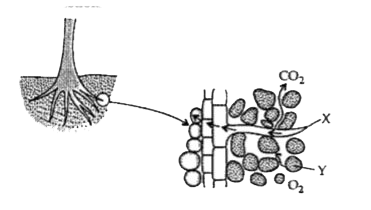Given below is a diagram depicting a physiological process in mammals. Study the same and answer the following questions :
(i)Name the process occurring in the diagram.
(ii)Explain the process mentioned in part (i).
Step-by-Step Solution:
1. Oxygen Transport: Red Blood Cells (RBCs) in the blood capillaries transport oxygen. The oxygen binds to hemoglobin in the RBCs to form a compound called oxyhemoglobin.
2. Oxygen Delivery: The oxyhemoglobin is then transported through the bloodstream to the tissues. Once it reaches the tissues, oxygen is released from oxyhemoglobin and diffuses into the body cells. This diffusion occurs through the thin walls of the blood capillaries.
3. Carbon Dioxide Collection: As the cells utilize oxygen for metabolic processes, they produce carbon dioxide as a waste product. This carbon dioxide diffuses out of the cells into the blood capillaries.
4. Carbon Dioxide Transport: The carbon dioxide is then transported back to the lungs in two main ways:
- It is dissolved in plasma as bicarbonate ions.
- It can also bind to hemoglobin to form carbaminohemoglobin.
5. Exhalation: Finally, the carbon dioxide is expelled from the body when we exhale.
This entire process is vital for maintaining cellular respiration and ensuring that cells receive the oxygen they need while removing carbon dioxide efficiently.
---
- It is dissolved in plasma as bicarbonate ions.
- It can also bind to hemoglobin to form carbaminohemoglobin.
Topper's Solved these Questions
- DIGESTIVE SYSTEM BOOK - ICSECHAPTER - DIGESTIVE SYSTEM EXERCISE - REVIEW QUESTIONS (MULTIPLE CHOICE TYPE)
4 Videos
- DIGESTIVE SYSTEM BOOK - ICSECHAPTER - DIGESTIVE SYSTEM EXERCISE - REVIEW QUESTIONS (VERY SHORT ANSWER TYPE)
3 Videos
- DIGESTIVE SYSTEM BOOK - ICSECHAPTER - DIGESTIVE SYSTEM EXERCISE - TOPIC 2 (3 Marks Questions )
12 Videos
- CELL:THE UNIT OF LIFE BOOK - ICSECHAPTER - CELL:THE UNIT OF LIFE EXERCISE - TOPIC 3(5 Mark Questions )
14 Videos
- DISEASES : CAUSE AND CONTROL BOOK - ICSECHAPTER - DISEASES : CAUSE AND CONTROL EXERCISE - Review Questions (D. LONG ANSWER TYPE)
5 Videos
Similar Questions
Given below is a diagram depicting a physiological process in man.
Study the same and answer the following questions :

Name the process occurring in the diagram.
Explain the process mentioned in part (i).
View SolutionGiven below is a diagram depicting a physiological process in plants. Study the same and answer the following questions :

Define the part X.
View SolutionGiven below is a diagram depicting a physiological process in mammals.
Study the same and answer the following questions :
Label the part .X. and .Y..
View SolutionGiven below is a diagram depicting a physiological process in animals.

Study the same and answer the following questions:
Define tissue respiration.
View SolutionGiven below is a diagram depicting a physiological process in man.
Study the same and answer the following questions :

Label the gases .X. and .Y..
View SolutionGiven below is a diagram depicting a physiological process in plants. Study the same and answer the following questions:

Label the part .X. and .Y..
View SolutionGiven below is a diagram depicting a physiological process in plants.
Study the same and answer the following questions :

How does stigma trap the pollen?
View SolutionGiven below is a diagram depicting a physiological process in animals.

Study the same and answer the following questions:
Explain both the process shown in figure ‘X. and .Y..
View SolutionGiven below is a diagram depicting a physiological process in man.
Study the same and answer the following questions :

Name the organelle where cellular respiration takes place.
View SolutionGiven below is a diagram depicting a physiological process in plants.
Study the same and answer the following questions :

Write two examples of plants showing this process.
View Solution
